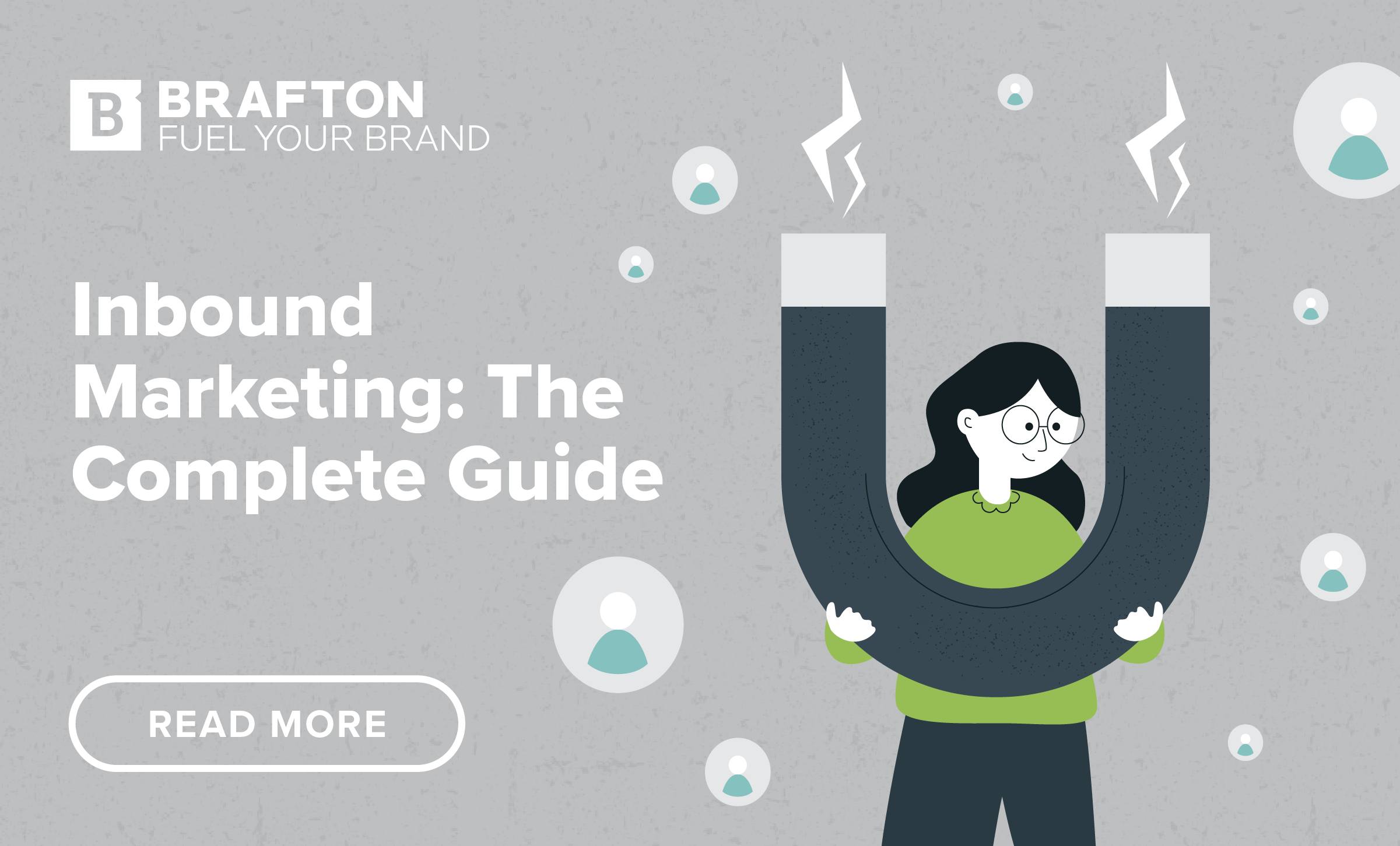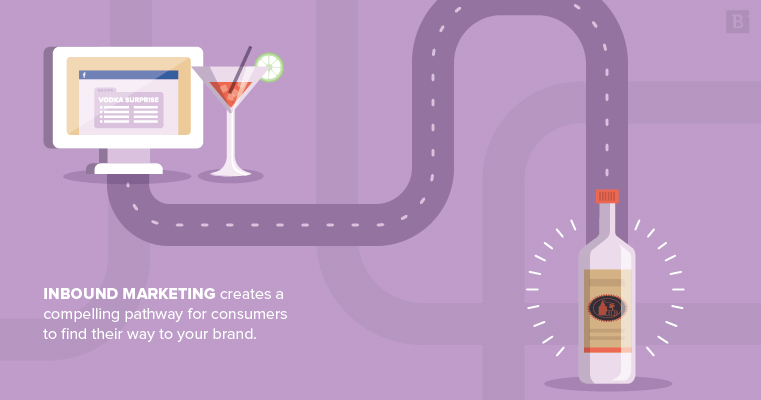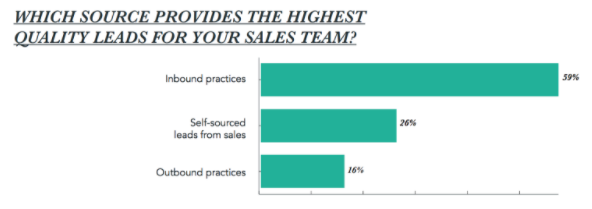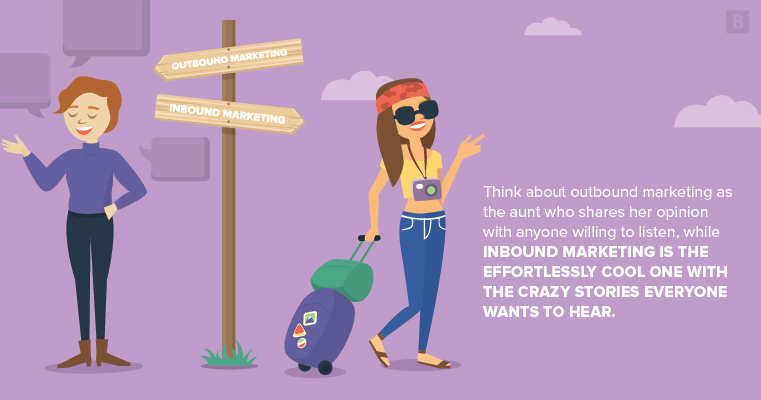Inbound marketing creates a compelling pathway for consumers to find their way to your brand.
It combines all the pieces of the puzzle: lead generation, lead nurturing, social media, email marketing, SEO, influencer outreach, strategy and analysis. Together, these inbound marketing services connect the right audience with your products and services.
There is no such thing as inbound marketing without content marketing. But these two terms aren’t synonymous. The difference is subtle, yet important.
Let’s talk about each concept and what makes the two of them a match made in heaven.

What Does “Inbound” Really Mean?
The idea behind inbound marketing campaigns is to organically attract customers to products or services through content creation, social media engagement and tactful SEO and SEM practices. That means customers find and engage with brands through communication channels such as:
- Blogs.
- Emails.
- Videos.
- Social media posts.
- Online search engine results.
Instead of approaching potential customers blindly with cold calls and generic sales pitches, the purpose of an inbound strategy is to provide audiences with relevant and valuable content. That way, marketers earn customer awareness rather than forcing it. Further, inbound marketing efforts drive qualified leads due to the nature of prospects coming to you with a need, rather than you creating a need.
An inbound marketing program focuses on long-term success with a goal of improving the customer experience and building trust, which translates to consumer interest, engagement and commitment.
And what’s the best way to do that? With engaging, reputable content.

How Does Content Marketing Come In?
Content is what sets inbound marketing apart from outbound marketing.
Think about outbound marketing as the aunt who shares her opinion with anyone willing to listen, while inbound marketing is the effortlessly cool one with the crazy stories everyone wants to hear.
The cool aunt is nothing without her riveting accounts of traveling the world and headbanging at rock concerts in the 80s. Just like inbound marketing is nothing without quality content.
Inbound marketing is all about being there for a potential customer when they need you. If they Google a question, your blog post about the topic should be there waiting for them. If they are searching for a particular product or service, a backlink on a reputable website should lead them to your landing page. And these assets that save consumers in their time of need are called content.
Content can be just about anything. It just needs to be something produced by your company that gives your target audience an intimate look into your brand. Once someone engages with your content, they should walk away feeling better because they know a brand like yours exists and will be there when they have a need only you can satisfy.
Content marketing exists within the inbound methodology. Creating content is a large part of the battle, but inbound marketing also includes placing that content in strategic places and promoting it in intuitive ways.
Inbound Content Marketing: The Best of Both Worlds
Inbound content marketing homes in on the relationship between these two concepts. It’s all about creating content that you know is bound to be noticed by potential customers. That means hitting hot topics and keywords within the content and then delivering it at crucial times and through apropos channels.
Before customers even decide to purchase a bottle of Tito’s Vodka, they may try a cocktail recipe the brand shared on Facebook. Or maybe they found small-space design inspiration online before even stepping foot in IKEA.
That’s the idea behind inbound marketing. When brands share relevant, helpful content, they add value at every stage of the buyer’s journey. The more they benefit from the content, the more likely people are to recognize the brand, visit their website or social pages and become a loyal customer.
Along with attracting and retaining audience attention, the purpose of inbound marketing content is to drive visitors to your website. And not just any old visitors, but the ones who are going to become new clients and loyal customers.
With extensive research and relevant buyer personas, inbound marketing allows brands to understand consumers more deeply and develop a more targeted approach to generate leads. That means inbound prospects can be far more valuable than outbound ones because they’re more likely to respond and engage positively with the content.
Once visitors reach your website – usually via search engines – inbound marketing means greeting them with a relevant landing page. Whether it’s a contact form to fill out, subscription page, specific product or calendar system for booking meetings, the landing page is the prime place to convert consumers. A strategic inbound marketing plan also means those landing pages are optimized to be high up on the list of those search engine results.
The inbound methodology can be made even more powerful by promoting organic, customer-centric content throughout the sales funnel. In this way, your sales team can build their own prospect pipelines and nurture leads with content your marketing team creates, such as case studies, customer testimonials and other mid- and bottom-of-the-funnel assets. That way, your marketing efforts can reach potential clients and customers at virtually every stage of the buyer’s journey. A unified marketing and sales strategy further allows for flexibility with leveraging content and better adaptability to market trends and customer needs.

Inbound Versus Outbound
Think about outbound marketing as the aunt who shares her opinion with anyone willing to listen, while inbound marketing is the effortlessly cool one with the crazy stories everyone wants to hear.

While outbound marketing strategies push products and services through various channels, an inbound campaign focuses on creating awareness and attracting customers with interesting content.
The content is interesting because it addresses problems, pressure points and needs of customers, targeting them on a more personal level. Thus, a significant difference between inbound and outbound is that the former creates a conversation with your target audience, rather than simply talking at them.
Another bonus for your budget: Content marketing costs 62 percent less than outbound marketing. That’s because the focus is on building organic relationships with your audience and investing in people, rather than pushing products and services through traditional marketing methods.
Bringing In the Leads
As brands leave the outbound world and employ content marketing, they see significant increases in lead generation.
In the State of Inbound 2017 report, HubSpot found that 59 percent of the surveyed marketers believe inbound marketing tactics generate higher quality leads. That’s compared to only 16 percent who responded outbound.

Inbound fits into marketing strategies and big-picture business plans by providing the services to generate awareness, traffic and leads. With content creation and execution that’s specifically targeted to ideal consumers, brands can build trust and credibility, while attracting more qualified prospects. In turn, many of those leads turn into sales.
What’s on Your List?
If inbound marketing can only be as good as the content, what kind of services do you need? Editorial, design, video and social. Plus, the strategy behind this content and the analysis to see how well it performs.
These content strategies are even more powerful when used together. Think about how much wider of an audience your blog posts will reach when they’re promoted via social media and optimized for search engines.
The best examples of inbound marketing campaigns home in on the services that make the most sense for the brand, ultimately putting their own spin on the inbound methodology. When you partner with a full-service marketing agency, its team members have the inbound tools, resources and expertise to check off all the items on your list and help you develop your own distinctive spin. Even better, they develop the perfect mix of content and strategy to significantly increase ROI and achieve business goals.
Here’s what to look for in each of these inbound marketing services:
The Strategy
Before you can create the content to drive leads, you need to determine what to say – along with how, when and where to say it.
When you work with a marketing vendor, consultants, strategists and project managers use their expertise to strategize the content that can deliver the most valuable results for your business.
Content marketing strategy involves services such as:
- Consulting.
- Data from SEO, SEM, UX, analytics and audit tools.
- Detailed buyer persona mapping.
- Brand messaging.
- Conversion rate optimization.
- Extensive keyword research.
- Email marketing.
- Performance metrics.
- Analytics reporting.

Successful application of these services offers brands the information to know exactly who they should be talking to, as well as how they can most effectively reach them.
From there, you’ll need content creation services for expertly written and designed products.
The Copy
Remember your aunt who has all of the great stories to tell? Well, a story is only as good as the person who delivers it. A storyteller not only needs good material, but also the skillset to get their point across in a concise, yet engaging, manner.
Strong copywriting is at the heart of inbound marketing, piquing consumer interest with the right tone, voice and subject matter.
Blog content remains a staple for inbound marketing strategies, with 53 percent of marketers naming it their top inbound marketing priority, according to the State of Inbound 2017 report.
The great thing about blogs is you can vary the topics and presentations to keep consumers engaged. Whether your blog content creation strategy calls for news-based articles on trending topics, educational evergreen pieces or thought leadership commentaries, an experienced writer can write the content that drives the most results for your business.
Editorial services that can help you tell your story include:
- Blogs.
- Email newsletters.
- White papers.
- eBooks.
- Case studies.
- Customer testimonials.
- Product or service guides.
- Landing pages.
- Banner ads.
- Lead generation emails.
Rather than posting content for the sake of it, these services ensure your brand is posting content with purpose.
The Design
Humans are visual beings. That means your consumers will react positively to professionally designed content.
In fact, visuals with color increase viewer desire to read a piece of content by 80 percent. Plus, consistent branding and well-designed pieces can elevate the credibility and relevance of the content.
Graphic design services can elevate your story to a visual level, with content such as:
- Custom illustrations.
- Branded infographics.
- UX and web design.
- Professionally formatted eBooks, white papers and case studies.
- Custom CTAs.
- Branded sales sheets, one-pagers, reports and guides.
- Email templates.
With these design services you can say goodbye to stock imagery and intimidating chunks of copy. Instead, engage your consumers with content that’s not only relevant and interesting but also easy on the eyes.
The Video
If you want to compete – not only with other brands but with the entire online world – share video content.
Videos are a quick and effective way to convey messages, making them fun and easy for audiences to consume. They can break down complex ideas, present brand stories and display products and services in action. To be real with you, they’re pretty much a staple in modern marketing campaigns.
Agencies with full-service video studios can produce content such as:
- Product demos.
- News updates.
- Interviews and testimonials.
- Video blogs.
- On-location shoots.
- Event coverage.
- Vox Pops.
- Animation and motion graphics.
- Step-by-step guides.
When you share the completed video assets on your website and social media pages, they offer benefits like brand awareness, audience engagement, increased organic ranking and conversions.
The Social
Once you have fabulous content, social media is how you can effectively share it with the world.
The key is to interact on the channels where your audience is already engaged. Social media consultants can help you determine what those platforms are. Plus, they can monitor how your content performs and make changes accordingly.
The social media marketing services to promote your content and generate conversions include:
- Consulting.
- Social media strategy.
- Channel management .
- Social media advertising.
- Live posting.
- Snapchat geofilters.
- Social media contest creation and management.
- Follower pushes.
- Influencer outreach.
- Custom promotional posts and emails.
- Detailed performance reports.
Social media strategists determine which services are most appropriate for your brand, helping you – and your content – find a relevant place in the social media world.
Finding the Right Vendor
So how do you decide which marketing agency can provide the killer services you need to rock your inbound marketing strategy?
Here’s how to look for the right content marketing vendor:
Do Your Online Research
First and foremost, do a quick Google search for content marketing agencies or inbound marketing services in your area. The first ones that show up probably have the best SEO and keyword strategies – that’s a great sign!
Next, check out the vendor’s website.
Is the landing page blah? Did you stop reading the copy on the About Us page before you made it to the third line? No sign of videos on their website? Scratch them off the list.
However, if the website entices you, there’s a good chance that agency can make your website just as engaging for your viewers.

Check Out Their Resume
Along with finding out how long they’ve been in business, case studies and testimonials are key to understanding vendors’ experience.
Plus, check out what kind of clients vendors worked with in the past. You may be inclined to partner with one that has relevant experience in your company’s industry.
Is the vendor a HubSpot partner? Do their employees attend HubSpot Inbound events? As the company that can take credit for inventing inbound marketing, an affiliation with HubSpot is always a good sign.
Talk to your network for recommendations as well. One of your connections may end up being a trusted reference for a potential vendor.
Look for Competitive Qualities
Along with relevant experience, you’ll want to make sure the vendor has the right soft skills to bolster their services.
Adaptable and agile methodologies are important qualities for inbound marketing agencies. It means they develop flexible marketing strategies that can be updated in real time.
Custom approaches are also a bonus. It shows a dedication to defining personal goals and a desire to become a truly integrated member of your marketing team.
Ask About the Process
You need high-quality content for your inbound marketing efforts to be successful. Your inbound marketing agency needs detailed and efficient processes to deliver that content.
Make sure the vendor you choose doesn’t rush into content creation without adequate research and planning. Without the right strategy, your content won’t perform.
Agencies with in-house services are often better partners, simply because the content is planned, created, executed and analyzed all under the same roof. Plus, you can work with the same strategist, project manager, writer and designer for a team that is always consistent and up to speed on your brand.
Consider Compatibility
It may feel like you’re entering the online dating world, but compatibility can be an important differentiating factor when debating between vendors.
Think about their values and mission statements. Do they resonate with yours?
Try to meet with representatives from the agency before sealing the deal. That way, you can see if you enjoy talking with them and whether the in-person interactions hold up to the email or phone conversations you’ve had.
From there you can find your perfect inbound marketing match.
With the right inbound marketing partner, powerful strategy and stellar content, you’ll have all the pieces you need to lay out that red carpet with finesse.
Editor’s Note: Updated July 2021.








